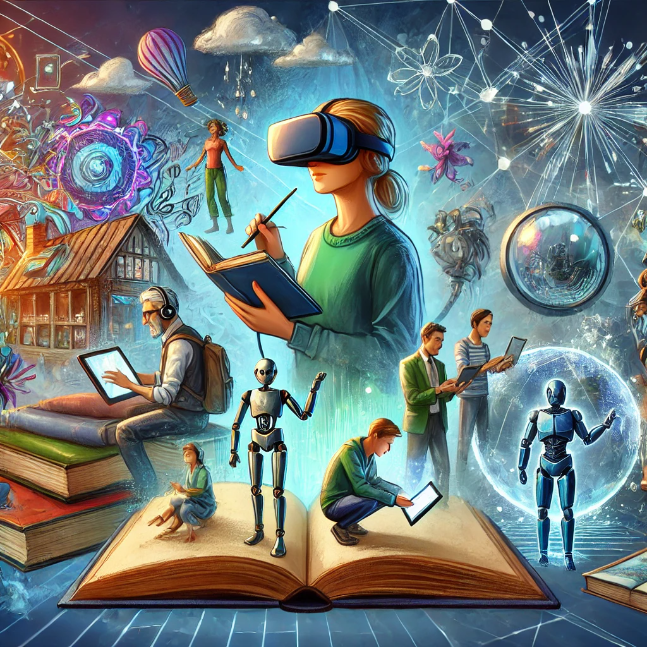The Evolution of Storytelling: Virtual and Augmented Reality VR AR in Books

In the digital age, storytelling has transcended traditional mediums, embracing cutting-edge technologies like Virtual Reality (VR) and Augmented Reality (AR). These immersive technologies have revolutionized the way stories are told, allowing readers to experience narratives in unprecedented ways. This article explores the impact of VR and AR on storytelling, highlighting live examples of how these technologies are transforming books.
The Rise of VR and AR in Storytelling
Virtual Reality (VR) and Augmented Reality (AR) offer immersive experiences that blend the physical and digital worlds. VR provides a fully immersive environment, often requiring headsets, while AR overlays digital content onto the real world through devices like smartphones or AR glasses. Both technologies enhance storytelling by engaging multiple senses, creating interactive experiences that captivate readers.
Benefits of VR and AR in Storytelling
- Immersive Experience: VR and AR allow readers to step into the story, exploring settings and interacting with characters in a 3D environment.
- Enhanced Engagement: Interactive elements keep readers engaged, making the narrative more compelling and memorable.
- Educational Value: VR and AR can provide educational content in an engaging manner, making learning more enjoyable and effective.
- Accessibility: These technologies can make stories more accessible to individuals with disabilities, offering alternative ways to experience narratives.
Live Examples of VR and AR Storytelling
"The Night Cafe" by Vincent van Gogh (VR Experience)
"The Night Cafe" is a VR experience that allows users to step inside Vincent van Gogh's famous painting. Developed by Borrowed Light Studios, this VR experience offers a unique way to explore van Gogh's artwork and gain insights into his creative process. Users can walk around the cafe, interact with objects, and even listen to an audio narration about the painting's history. Learn more about this experience in our article on "The Night Cafe" by Vincent van Gogh: A Virtual Reality (VR) Experience.
"The Raven VR" by Edgar Allan Poe
"The Raven VR" is an immersive adaptation of Edgar Allan Poe's classic poem. This VR experience, available on platforms like Oculus Rift, places users in a 19th-century Gothic setting, where they can interact with the environment while listening to a dramatic reading of the poem. The eerie atmosphere and interactive elements enhance the poem's haunting themes, making it a captivating experience for both literature and VR enthusiasts. For more details, check out our article on "The Raven VR by Edgar Allan Poe: A Virtual Reality (VR) Experience.
"Between Worlds" by Skip Brittenham (AR Book)
"Between Worlds" is an AR-enhanced book by Skip Brittenham that brings the story to life through AR animations and interactive elements. Readers can use the accompanying app to scan the pages and unlock hidden content, such as animated scenes, character profiles, and interactive puzzles. This fusion of traditional storytelling and AR technology creates a dynamic reading experience that engages readers of all ages. Explore this innovative book in our article on Exploring Between Worlds by Skip Brittenham: An Augmented Reality (AR) Adventure.
"War Remains" by Dan Carlin (VR Experience)
"War Remains" is a VR experience created by historian Dan Carlin, known for his "Hardcore History" podcast. This VR documentary takes users back to the trenches of World War I, providing an immersive and educational experience of the war. The combination of realistic visuals, sound effects, and historical narration offers a powerful way to learn about history through VR storytelling. Learn more in our article on "War Remains by Dan Carlin: A Virtual Reality (VR) Experience.
"The Wild" by Aerie Digital (AR Children's Book)
"The Wild" is an AR children's book by Aerie Digital that uses AR to create an interactive reading experience. By scanning the pages with a smartphone or tablet, children can see characters come to life, interact with animals, and solve puzzles related to the story. This innovative approach makes reading fun and educational, encouraging children to explore and learn through storytelling. Discover more about this book in our article on "The Wild by Aerie Digital: An Augmented Reality (AR) Children's Book Adventure.
The Future of VR and AR Storytelling
As VR and AR technologies continue to evolve, the possibilities for storytelling are limitless. Authors and developers are constantly exploring new ways to integrate these technologies into their narratives, creating richer and more immersive experiences. The future of storytelling lies in the seamless blend of traditional and digital mediums, offering readers new and exciting ways to engage with stories.
Conclusion
Virtual and Augmented Reality have transformed the landscape of storytelling, offering immersive and interactive experiences that captivate readers. From VR adaptations of classic literature to AR-enhanced children's books, these technologies are revolutionizing the way we experience narratives. As VR and AR continue to advance, they will undoubtedly play a significant role in the future of storytelling, pushing the boundaries of creativity and engagement.
For more insights into the future of reading with VR and AR, check out our detailed article on Virtual and Augmented Reality (VR/AR) Storytelling and Books: The Future of Reading. Discover how these technologies are shaping the future of books and storytelling.



